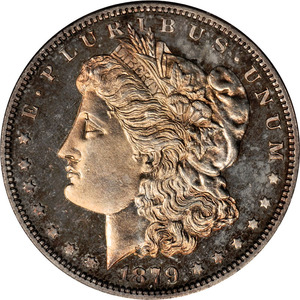Almost everyone that picks up a silver dollar just instinctively holds it, turns it over, pinches in two fingers and studies it. Those simple actions alone can devalue a coin immediately, due to the fact that the oil in the skin of your hand will etch a fingerprint in that coin…some will be visibile immediately, others may take years to appear, but eventually, your fingerprint WILL show up on the coins surface.
If you visit a coin show or museum of rare artifacts, you will notice that experts almost always hold the coin or item by two fingers, on the top and bottom of the rim, pinching it so that you don’t drop it. It’s also very common practice to wear cotton or thin surgical gloves so as not to damage the coin.
Keep in mind that you are handling a coin that is 100s, sometimes thousands of years old, depending on the coin, and the fact that it is in your hands is in itself, a miracle. For it to have survived the effects of handling, jostled from buyer to seller, spending thousands of hours in pockets, rubbing against house keys, other coins, who knows what, but most importantly, it has survived. That makes it your job as a collector to insure that it’s condition and value are not degraded by further skin oil, ticks, dents, dings or by being dropped.
The first evaluation of any coin is to determine if it has been circulated, ie: in common everyday use. If it has been, it will show signs of wear, the aforementioned nicks and fingerprints, and wear. Coins that have been used will have been slide across countless tables, countertops, bars, etc, as it transitions from one persons possession to another. Those coins are then put into a separate category of “circulated.” This simple determination will help you grade the coin.
All coins are now graded using a 1 through 70 scoring system, with 1 being the lowest and most circulated and used condition and 70 as it came out of the mint that produced the coin. Silver dollars were minted in San Fransicsco, Denver, Philadelphia, Carson City and New Orleans, and the mints stamped a letter on each coin and this was known as it’s “mintmark.” To this day, a coins value can be increased by being from Carson City (CC) or New Orleans ( O ) or San Fransisco ( S ) due to the mere fact that there will have been lesser quantities of coins produced from those mints in that year.
When I look at a coin for grading purposes, I look at its brilliance, wear, damage, toning, mintmark, and then, I establish the number that were minted in that year and mintmark. Those key factors will give me all I need to know to start to establish its market value. There are sites online that will give you exact numbers based on mint records, of how many coins were produced at each mint each year, and I turn to them for that data.
These basic factors are how I evaluate the market value of my Morgan silver dollar…I will go into each of these methods in detail in my following articles, which include: Luster vs toning, Determining wear on Morgans, Varieties and error coins, and The value of a Morgan based on mint numbers. I am a die-hard Morgan collector and enthusiast, and have enjoyed marketing them on eBay, Teletrade and Amazon over the years, and am happy to share my experience and knowledge so that you can profit from it!
